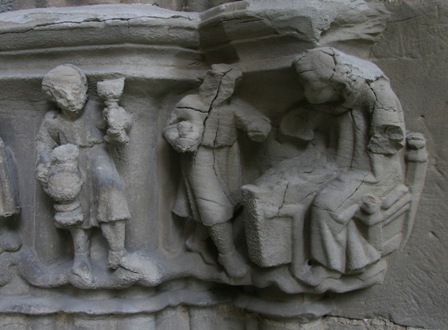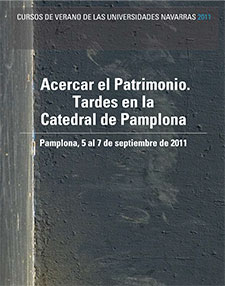BRINGING HERITAGE CLOSER. EVENINGS IN PAMPLONA CATHEDRAL.
5 September 2011
Capitals and keystones of the cloister of the Cathedral of Pamplona. That unknown world
Ms. Clara Fernández-Ladreda Aguadé. University of Navarra
The importance of the complex made up of the cloister and Gothic rooms of the cathedral of Pamplona, both for its exceptional character -unique in Europe and therefore in the world- and for its quality and beauty, and the sophistication of the iconographic programs of its plastic art, has been widely recognized by specialists, although perhaps less so by the public. Despite this, the element core topic of the complex, the cloister, is in an alarming state of deterioration and it does not seem an exaggeration to say that its very existence is threatened.
The first awareness of the status arose as a result of a photographic campaign carried out in 2002 with the erection of scaffolding. As a result, in October 2003, the then head of the Section of Movable Goods and Heritage of Príncipe de Viana, Mercedes Jover, accompanied by the technician of the same Section, Alicia Ancho, made a reconnaissance visit to visit . Subsequently, they entered contact with the architect Leopoldo Gil of the Architectural Heritage Section of the same Institution. In November of the same year, it was decided to commission high school of Spanish Historical Heritage -currently high school of Spanish Cultural Heritage- with a preliminary study in order to analyze the extent of the damage and propose remedies. As a result of the report, delivered in July 2004, a agreement was signed between the Ministry of Culture and the Government of Navarra and a second comprehensive study was commissioned in 2007, sponsored by both institutions and carried out by qualified specialists. The report, which indicated that the restoration -although complex- was possible and made a proposal of the actions to be carried out, was delivered in 2008.
Unfortunately, for various reasons, the next phase was not carried out: the implementation of the restoration process, beyond some palliative measures, successful but insufficient. As a consequence, the deterioration progresses and the danger worsens.
In order to draw the attention of society and the authorities, a particularly threatened part of the cloister was chosen, the capitals, from which a significant sample was selected. From this point on, the path followed was twofold. On the one hand, departing from the more usual approach , emphasis was placed on the formal aspect, that is to say, on the beauty and quality of the works, incidentally alluding to the intellectual complexity of the programs of some of them. On the other hand, the Degree of deterioration and the losses suffered were highlighted, through comparisons with photographs of some years ago belonging to the file Fotográfico de Príncipe de Viana.
The idea that the cloister was totally polychromed was also emphasized, which not only gave it a very different appearance, but also made it extraordinarily easy to see. To this end, images were presented of some elements that still maintain the polychromy or remains of it, particularly the keystones. Now we can only hope that those who have the responsibility and the resources will adopt, slowly but surely, the appropriate measures to save this jewel of Navarre's and universal heritage, so that future generations can continue to enjoy it.

Capital with scenes of fighting and hunting

Capital of the Tower of Babel. Architect and servant
PROGRAM
Monday, 5th September
The Cathedral in the History of Navarre: the cathedral, the chapter, the institutions and the bishop.
D. Luis Javier Fortún Pérez de Ciriza. Royal Academy of History
Capitals and keystones of the Cloister of Pamplona Cathedral. That unknown world
Ms. Clara Fernández-Ladreda Aguadé. University of Navarra
Travellers' views of Pamplona Cathedral
Ms Carmen Jusué Simonena. UNED of Pamplona
Tuesday, 6th September
Sumptuary arts in the Cathedral
D. Ignacio Miguéliz Valcarlos. Chair of Navarrese Heritage and Art
Artists in the Cathedral. Esteban de Obray, master of choir stalls.
Ms. María Concepción García Gainza. Chair de Patrimonio y Arte Navarro
A stroll through the canonical dependencies of the cathedral
Mr Javier Martínez de Aguirre. Complutense University of Madrid
Duplicate visits to the cathedral complex in Pamplona
Wednesday, 7th September
Golden scenery: the baroque altarpieces
D. Ricardo Fernández Gracia. Chair of Heritage and Navarrese Art
The cathedral today and tomorrow: projects in progress
D. Francisco Javier Aizpún Bobadilla. Episcopal Vicar for Heritage. Archbishopric of Pamplona
CLOSING: Concert at position Choir Santa María la Real de Voces Graves

